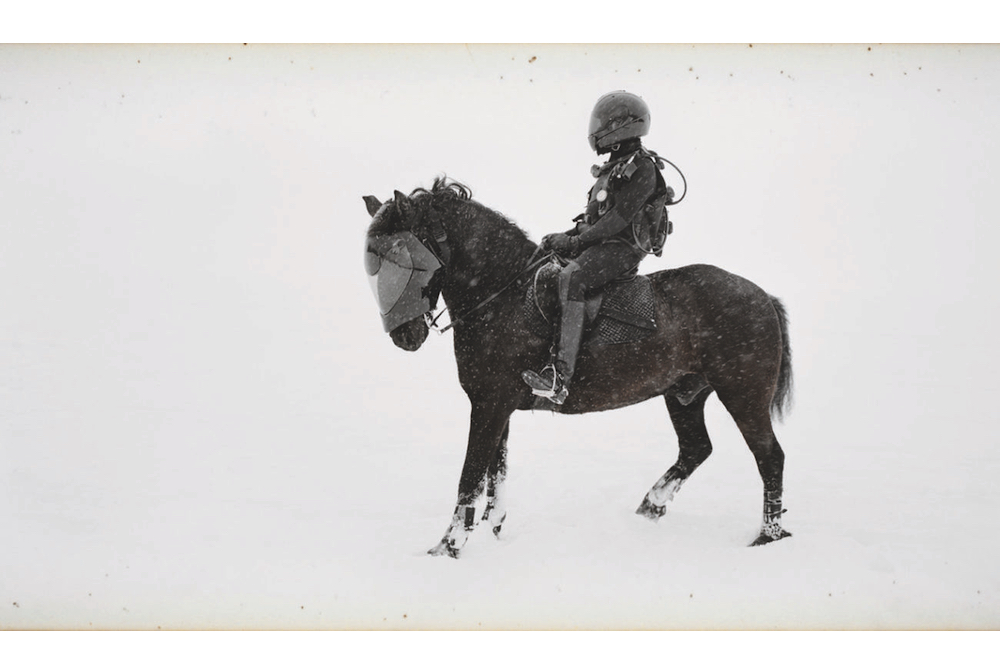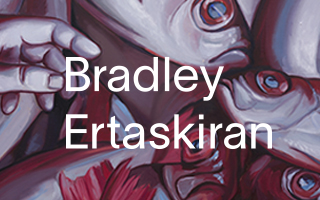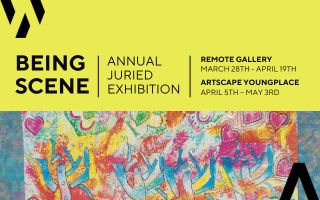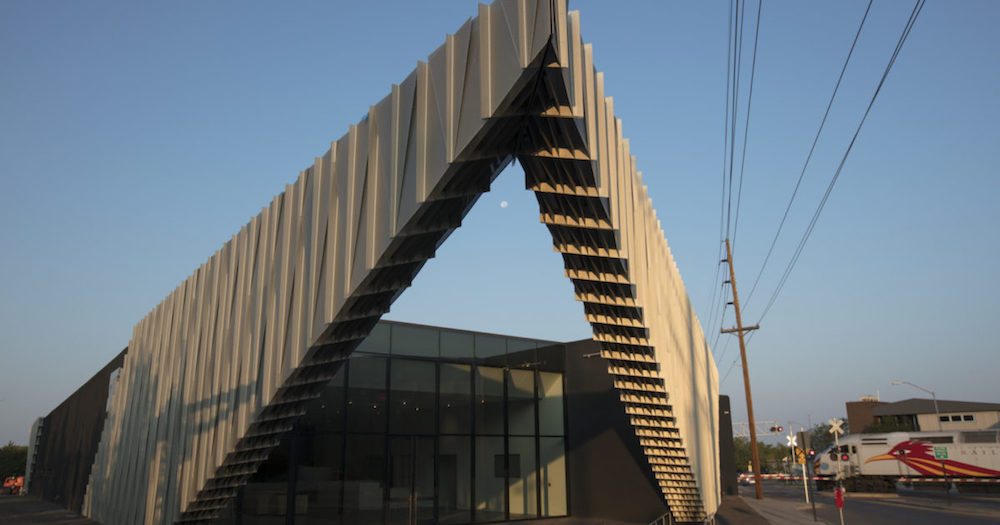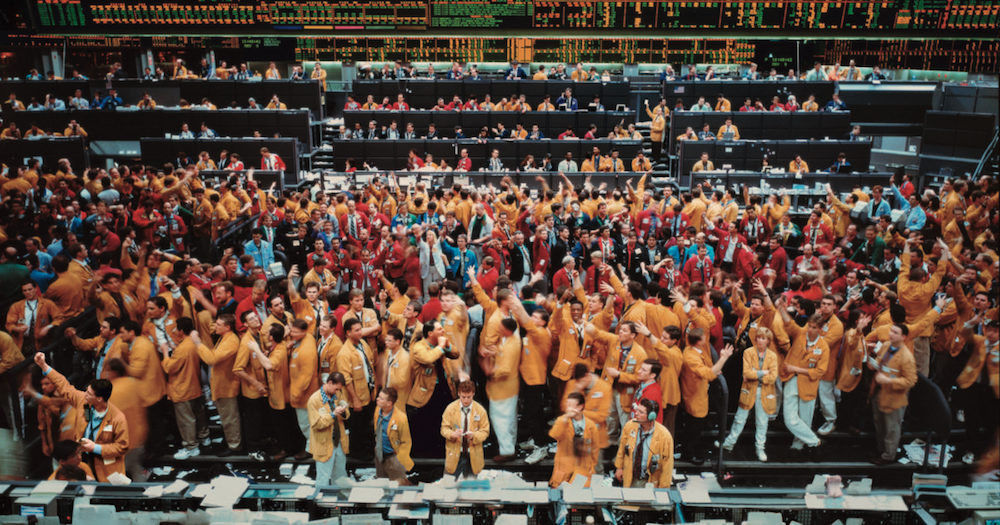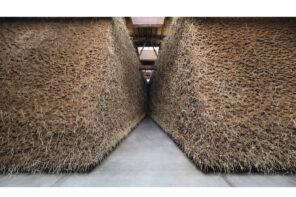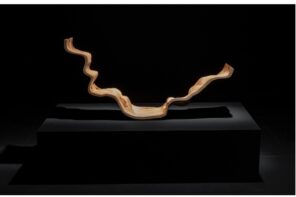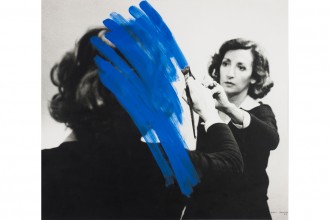Two brand-new, chunky metal triangles jut out and join above the glassy entrance of the black cinderblock edifice that houses the recently-renovated SITE Santa Fe. Surrounded by buildings of mud-red and adobe-brown in an old industrial hood that has more lofts these days than factories, at night the double-triangle’s aluminum cladding (that its designers, ShoP Architecture, call a “prow,” as on a ship) lights up, shining through the thousand holes poked in its skin to make a flickering moire. A boat on top of a desert mountain. SITE was founded in 1995 as an outpost for international contemporary art in this sleepy Southwestern capital (pop. 83,875), a high desert city best-known for summer tourists and wealthy retirees, Spanish colonialism and native craft. New Mexico labels itself the Land of Enchantment, though more than one local, when I repeated this slogan, offered the corrective: “Land of Entrapment.” The shivering aspen and piñon trees around the city make it easy to see why any passing painter might think to linger.
What’s at stake when an art space expands? It’s some kind of bet on the future, an institutional prediction about the kind of art and audience it intends to support. SITE’s founding occurred in a very specific moment of global art exchange when even a small Southwestern city could open with a serious international biennial. How SITE looked to the future from then and how it looks to it now, matters.
If we take SITE’s additions as a vision for what’s to come, the glimpse we’re afforded appears altogether status-quo and functional. With a $6.8 million price tag, most of the renos at SITE were of a less-showy variety than that jutting prow. Moving from a scrappy non-profit model to something more institutional, the biennial added climate-control for the galleries and storage area, a multi-purpose auditorium for public programming and events, an education space/conference room, a courtyard, and a spacious lobby with a small cafe and giftshop. The prow doesn’t do much functionally or aesthetically, but adding heat and AC is a difficult thing to fundraise for (even if it is ultimately necessary to show certain works of art). Though the architects mentioned budget limitations three times in the first ten minutes of their press tour, pricey renovations of a certain shape make it easy to think of SITE as a metaphor for larger forces. For the main exhibition in the new building, curator and SITE director Irene Hoffman took her title from Alvin Toffler’s 1970 book Future Shock, which, according to its cover, “can help save us from our collision with tomorrow.”
With 5 million copies sold in the US alone, Toffler’s book popularized futurism. And the exhibition it’s named after selects an array of artists that either deal with darkling technologies or offer escape from them. Of the ten artists included in SITE’s Future Shock, the youngest was born in 1972, the most senior in 1939. Age is hardly a marker of one’s depth of forward vision or aesthetic quality but it seems worth pointing out that the future imagined here is one defined by people aged 45 to 78 (the generation of the vast majority of our politicians) and based on a book that itself was published 47 years ago. The exhibition catalogue opens with a thirty-page list of “Future Shocks,” beginning with the atomic bomb in 1945 and concluding with mobile phones and CCTV (by way of global warming and mass extinctions). This timeline primarily casts the future through technological determinism – as does Toffler’s book – ignoring all the other myriad contributions that have also helped define progress, from the social to the aesthetic. One of the problems with technological determinists is that their solution to the ravages of technology is always more technology: stoking fears to then sell solutions. Toffler parlayed his books into a lucrative consulting agency for the private sector and government clients.
According to Toffler, and underscored by the artists in the exhibition, the future is pretty bleak. Though not every work forebodes, the combined effect is dystopian. There’s surveillance, AI, and creepy facts about genetic modification from Lynn Hershman Leeson; low-tech fakeries of manned space missions by Tom Sachs; more surveillance from Rafael Lozano-Hemmer, with Krzysztof Wodiczko; high-production/low-concept movies of wild animals in humanless Western roadside motels by Doug Aitken; bright, representational paintings by Alexis Rockman of animals at war in zoos, and other landscapes bereft of humans; a music video by Patrick Bernatchez wherein a lonely Mad Max/Daft Punk warrior rides a horse through a vast, vacant snowscape wearing a watch that only revolves every thousand years; Dario Robleto’s presentation of relics of the once-futurist Crystal Palace from London’s 1851 World’s Fair alongside vacant covers of live records from dead musicians; autarchic off-the-grid life projects from Andrea Zittel; and Regina Silveira stickering the museum’s windows with black-vinyl insects from plagues. The exhibition posits that artists can come up with revelations and solutions that technology cannot, but the result is largely one of anxiety, disappearance, and escape.
With rare moments of grace in the work of Robleto and Zittel, who offer the aesthetic of disappearance and a highly conceptual form of drop-out survivalism (neither of which feel all that hopeful, in context), the art largely fingers our fears and nostalgias. There’s a sweetness to Tom Sachs’s ersatz and jerry-rigged space missions, but it’s also steeped in a basement tinkerer’s yearning for the glory of a Cold-War space-race. The architecture that houses it all finds an easy emblem in ShoP’s metal prow, a useless thin scrim of metal on a cinderblock white cube that can’t even provide shelter from the rain. The interior galleries resemble contemporary art spaces almost anywhere in the world, which is unremarkably common to be sure, but given Future Shock’s purported questioning of the technologies that shape our perceptions, the missed opportunity of self-reflection feels especially disappointing.
It isn’t SITE’s fault that this model of boxing art in with a bit of superficial cladding as a part of an urban renewal feels emptied out: the staff are dedicated and the kunsthalle’s functionalism in a converted industrial space feels solidly normal. Yet, it’s still mediated by an architectural program that struggles to find much relevance. SITE and its eponymous biennial (with which it established its reputation internationally) were founded in a thrushing and buoyant burst of globalization after the end of the Cold War. The interconnectivity of the internet and inexpensive travel suddenly connected people and ideas in a way that felt dangerously exciting, and a sleepy town with an aesthetic bent like Santa Fe was suddenly imaginable as a site of all this energetic confluence. Today, however, the consensus of international exchange as we knew it is crumbling across the planet against a surge of nationalism. It’s an ideology on the rise at least partly because huge swathes of the global electorate feel left out of the benefits promised by their leaders. These nationalist blocs often vote out of a nostalgia for a false past over any hope for the future, even as they back a military-industrial complex that invests heavily in technology’s bleeding edges. Contemporary art is one of modern globalism’s great standards, served to us under the auspices that art is good for us. And though historically the hoi polloi has rejected vanguardism, does it surprise anyone when leftists picket art spaces, as they have recently in L.A. decrying gentrification? SITE was founded in the drunken exuberance of a new world order mediated by connective technologies. Now it seems to be contending with the hangover and fallout of the circumstances that bore it. The best one can do in any hangover, perhaps, is to hunker down and put on a good face, try to save what we can.
The dry air of the desert has always been preservative. Future Shock and the architecture of SITE’s new building discourage hope for what the future can be, but rather suggest an inclination to protect and fortify, to fret without offering much of an escape. I left wondering, what does it mean to add a new prow to a sinking ship?

